The first FA Cup final: A shilling to get in, no nets and seven up front
- Published

Football in the late 19th Century was a chaotic affair as this illustration of an early England v Scotland game at the Oval shows
Saturday's FA Cup final between Arsenal and Aston Villa at Wembley will be watched by half a billion viewers in more than 120 countries.
Close to 90,000 fans will be at Wembley for the 134th final of the world's oldest cup competition as two teams of elite, millionaire sportsmen battle it out for glory.
But what exactly was the scene at the original final way back in 1872?
An estimated crowd of 2,000 were there to see 22 amateurs play on a cricket pitch, with no nets, as Wanderers beat Royal Engineers 1-0 thanks to a goal from Morton Betts.
BBC Sport, with the help of Matthew Taylor, professor of history at De Montfort University, look at the first final 143 years ago...
The best 15 teams in the land
Prior to the 1872 FA Cup, there were no regular competitive games being played in England. Football Association secretary Charles Alcock drew up plans for the first FA Cup which saw 15 teams enter the first round of November 1871.
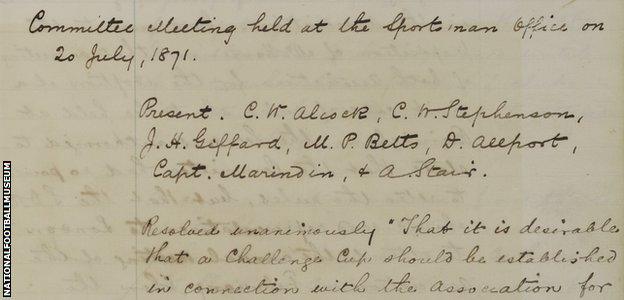
As this letter from July 1871 shows, an FA committee established the first FA Cup. Letter courtesy of the Football Association and the National Football Museum
Step forward Barnes, Civil Service, Hitchin, Crystal Palace (confusingly not the present-day Palace but their precursors who were dissolved in 1876), Maidenhead, Marlow, Queen's Park, Donington School, Upton Park, Clapham Rovers, Royal Engineers, Reigate Priory, Wanderers, Harrow Chequers and Hampstead Heathens, who were given a bye.
Teething problems and the logistical headaches of scheduling football matches across Britain in the era of steam meant that Scottish side Queen's Park advanced to the semi-finals without actually playing a game.
The semi-finals - both goalless draws - were played at the Kennington Oval. The Royal Engineers booked their place in the final with a 3-0 replay win over Crystal Palace, while Wanderers made it through when Queen's Park decided they could not afford another costly trip to London for the replay and withdrew.
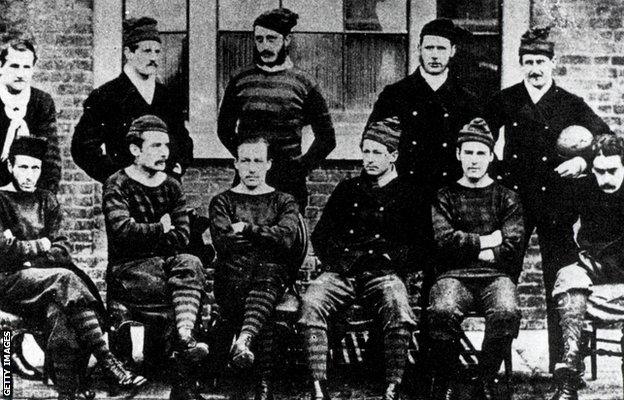
A (gentle)man's game: The Royal Engineers side of 1872
The historian's view: "The general consensus is that the FA Cup was based on the knockout competitions between 'Houses' at major public schools such as Harrow. But Alcock may also have taken inspiration from existing competitions in the provinces, such as Sheffield's Youdon Cup, launched in 1867.
"Certainly football was equally, if not more, established and popular in Sheffield as it was in London at this time, and the elite ex-public schoolboys based in the capital knew and played against teams from Sheffield, Nottingham and elsewhere."
Invented the Cup, ran the FA
Alcock - the brains behind the whole idea - played in defence for Wanderers.
Formed in 1859 as Forest Football Club, the side mainly consisted of former Harrow public schoolboys and took the name 'Wanderers' because they played their matches at different grounds. But by 1869 the club was based at the Kennington Oval, where Alcock also happened to be the secretary of Surrey cricket club.
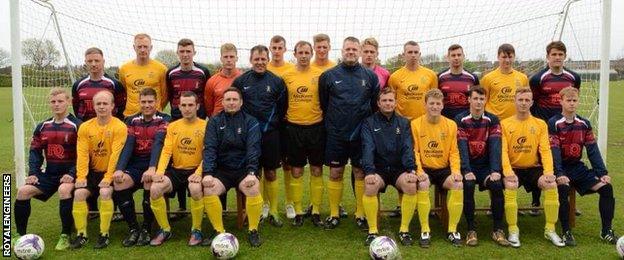
The Royal Engineers are still playing and still proud of their heritage.
The Royal Engineers were founded in 1863 by Major Francis Marindin - an extraordinary man. Having served in the Crimean war, he would go on to play in the 1872 final, become president of the FA in 1874 and then referee eight further FA Cup finals.
'Wanderers attacking from the Vauxhall End'
The 1872 final was held at Kennington Oval, also the venue for the first international football match between England and Scotland in 1870.
The Oval would go on to host 20 of the next 21 FA Cup finals, with the 1873 final played at Lillie Bridge - close to Chelsea's modern home at Stamford Bridge.
The historian's view: "Many football clubs played on cricket grounds in the late 19th century. Football clubs often emerged from existing cricket clubs, as a way of the players keeping fit in the winter. Purpose-built football grounds did not emerge in significant numbers until the 1880s and 1890s."
A shilling on the door
While fans at this year's final will have to battle through the crowds at Wembley, it was a more sedate affair in 1872. Football had yet to catch on and around 2,000 are said to have been at the Oval.
Much has changed beyond recognition in football but the cost of attending remains an issue...
The historian's view: "Attendances for football matches were not large in the early 1870s, with one reason for the relatively low attendance the price of tickets, which at one shilling (five pence in today's money) was higher than for most matches at the time.
"The Oval crowd was said to be 'very fashionable', so presumably made up of the well-to-do and the upper middle-class, as well as those connected with the 'old boys' public school network that ran the Football Association at this time."
Wanderers will play 2-2-6
The Royal Engineers could lay claim to being the Barcelona of their day, with their revolutionary tactic of 'passing' the ball to a team-mate at odds with the usual approach of chasing the ball into space.
The only goal of the final came after 15 minutes when Betts, playing under the pseudonym "A H Chequer", derived from his membership of the Harrow Chequers club, collected the ball after a long dribble from Walpole Vidal and slammed home.
Goalkeeper was not yet a specialist position, with keepers regularly playing outfield.

The original rules of the FA Cup stated that the winners could choose where to play the following year's final. Courtesy of the Football Association and The National Football Museum
The historian's view: "It was not unusual for teams to line up with six or seven forwards in the early 1870s. Most teams at this time still relied primarily on individual dribbling, with team-mates backing up the dribbler in an effort to move the ball towards the opponents' goal.
"Some authorities have claimed that the Royal Engineers were the first team to develop a passing game, and were doing so at around the time of the first FA Cup final."
The banker, the vicar and the Crimean War veteran
It's fair to say that the footballers of Oscar Wilde's age were a different breed to today's sporting stars.
The Wanderers' band of ex-public schoolboys and the aristocratic elite produced some notable sportsmen. As well as the pioneering Alcock the team contained several men who played first-class cricket, a goalkeeper who was capped by England as a defender and a forward who was capped by England in goal.
Forward Edward Bowen was noted for walking the 90 miles between Cambridge and Oxford in 26 hours in between his football and playing cricket for Hampshire; full-back Edgar Lubbock went on to become the deputy governor of the Bank of England and wing-wizard Walpole Vidal - known as the "prince of dribblers" - would later become a vicar.

What the players were playing for in 1872. An original medal, courtesy of the Professional Footballers Association and the National Football Museum
As you would expect, the Royal Engineers side had all seen military service from across the world, with experiences branching from India to the Crimea, Bermuda, Gibraltar and the Zulu war.
Forward Henry Waugh Renny-Tailyour played football and rugby union for Scotland as well as cricket for Kent and would still find time to become a managing director of Guinness, while half-back Alfred Goodwyn would suffer the unfortunate fate of being the first international footballer to be killed in a riding accident in India two years after the final.
The historian's view: "Most of the players in the first final had learnt the game in elite public schools and at university. The Wanderers was open only to those who had attended leading public schools and Oxbridge. Three of the Cup final line-up had attended Eton and four had gone to Harrow."
'Our ball ref!'

'Did that cross the line?'
The early rules were very different. In a nod to cricket, players had to appeal for a goal and changed ends after each goal, not at half-time. This once allowed Walpole Vidal to score three times without the opposition touching the ball.
The historian's view: "Modern fans would be surprised by some of the features of football in 1872. Rather than a crossbar, a tape was pitched between two posts eight feet above the ground.
"Throw-ins were not determined by the team whose player had kicked the ball off the pitch but by the first player to reach the ball. But these rules were not consistent across the country. Variations existed in different areas and it was not until 10 years later, in 1882, that a uniform set of rules was established by the FA."
Death, taxes, and referees from Whitehall
The 2015 final will be refereed by Jon Moss, who can expect some grief from the stands. It was a different story for civil servant Alfred Stair, the referee chosen for the first three FA Cup finals. Stair was the head of the Inland Revenue - presumably seen as a trustworthy gentleman of his day - and also played football for Upton Park.
The historian's view: "In the earliest days of football, referees were literally peripheral figures. They stood outside the playing area and were only called upon to adjudicate if the umpires (who were appointed by each club and stood in either half of the pitch) could not reach agreement."
What happened next?
For winners Wanderers it was the start of a golden - if brief - era of success. They retained the trophy in 1873 by beating Oxford University 2-0 and added three more trophies before the end of the decade. Their haul of five FA Cups has only been bettered by Blackburn Rovers, Newcastle, Aston Villa, Chelsea, Liverpool, Tottenham, Manchester United and Arsenal.
But by 1881 Wanderers could not field a side as players left to play for some of the newer clubs springing up across the country and the team folded in 1887. A reformed side was founded in 2009 and the club currently play in the Surrey South Eastern Combination. In fact they are looking for a new manager, external to get the club back in the FA Cup by 2022.
The Engineers reached four finals and won the Cup in 1875. They continue to play on and are currently managed by Capt Simon Mayers, who has a 25-man squad to select from around 8,000 men based around the world.
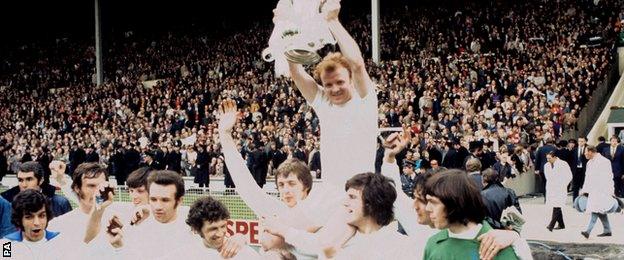
Wanderers in 1872, Leeds United in 1972 - who will win the FA Cup in 2072?
The historian's view: "Football became increasingly popular over the next decade or so, as it became embedded in British working-class culture. Its popularity was helped by entrepreneurs who realised the opportunities that existed in enclosing playing fields and charging the public for entry.
"The next step from this, as teams began to act as representatives of their localities, was for ambitious club committees to 'poach' the best players and pay for them to play for their teams. Within less than a decade of the first FA Cup final, professional football had emerged in England, though it was not legalised by the FA until 1885."
- Published26 May 2015
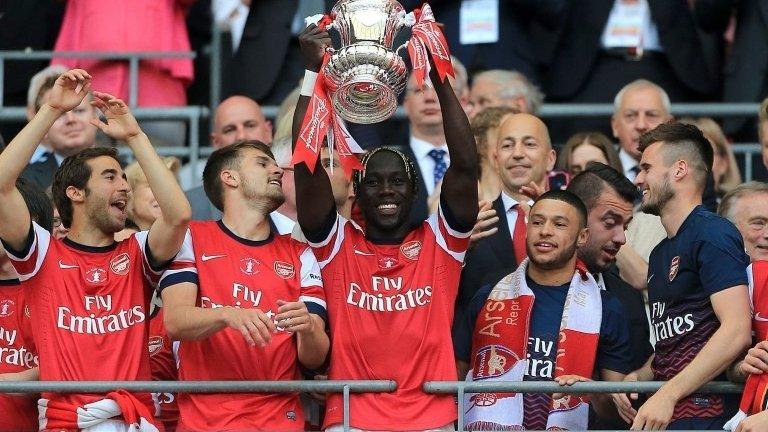
- Published1 June 2018

- Published22 April 2015

- Published30 January 2014
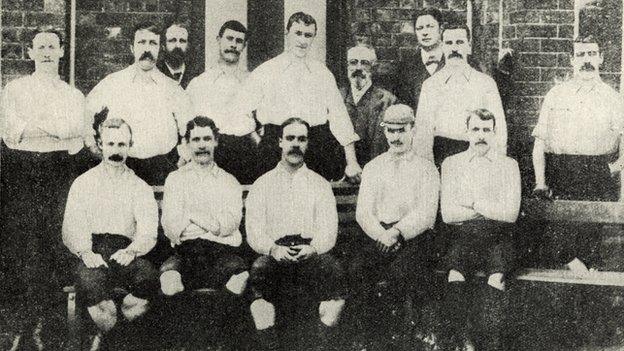
- Published2 November 2018

- Published20 June 2016

- Published7 June 2019
